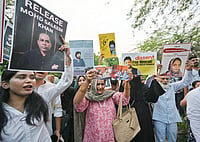“Because what you guys are doing right now in Belgium is actually worse. You agreed, but you are not taking any measures. Only blablabla. Bingbangboom.” This quote is from a video of US President Donald Trump berating Belgium before threatening to pull out of the Paris climate accord, something he eventually did. However, the video, created by the socialist Flemish party in Belgium, was later found to be fake, and so was the quote.
It is being touted as the latest technique in misinformation, with The Washington Post reporting this week that Russia is now looking to threaten democratic processes in the US through ‘deepfakes’.
Deepfakes are videos generated through an artificial intelligence (AI) algorithm which make them look unquestionably real, especially when created with a specific purpose. They surfaced first in pornography when a user on Reddit created videos where actors like Gal Gadot and Emma Watson were shown performing sexual acts. The videos were outed as fakes and have been banned by Twitter, Vimeo and Pornhub.
In the case of Trump, a Flemish party spokesperson told Politico that a professional studio created the content and it was not intended to dupe their own party supporters, some of whom fell for it.
With trust in the media declining and digital literacy still low, deepfakes could pose unforeseen consequences in a country like India where rumours on WhatsApp alone are enough to incite violence and mob lynchings.
“With deepfakes as of now, the principle is from the blinking system. You need a lot of photos of the person that you need to replicate. So when you see a deepfake video you won’t see a lot of blinks,” says Sagar Kaul of Metafact, an AI-based fact-checker. Kaul says that moving forward the technology may change but deepfakes would be something where “we would be able to tell 100 per cent if the image or video is fake. Because with deepfakes, we need to understand how the manipulation works and come back, so it’s a reverse process. There is no chance of a false positive. And it leaves a digital footprint, you have to pick up on those,” Kaul explains.
That said though, with the volume of misinformation at play and the ability of digital content to seep into hidden networks, deepfakes may add a misinformation quotient which will be difficult to get around, experts say.


























